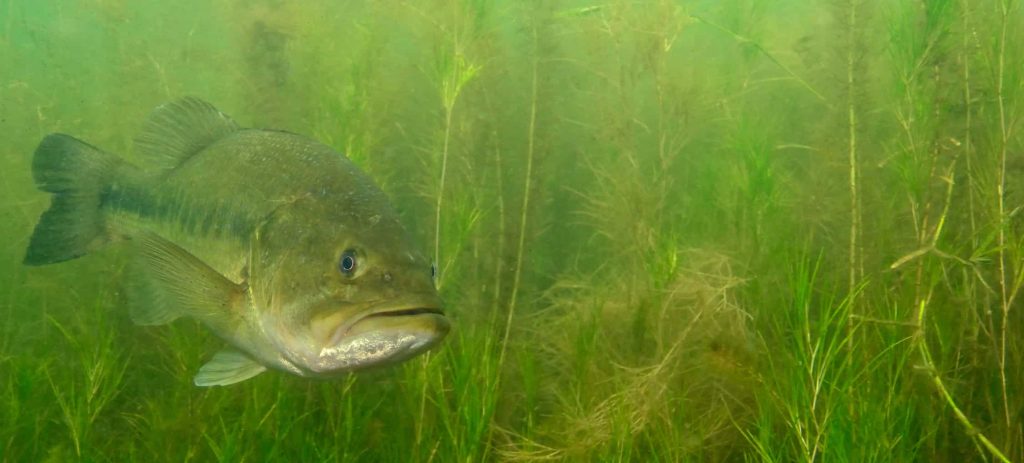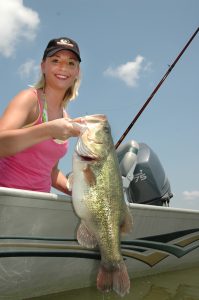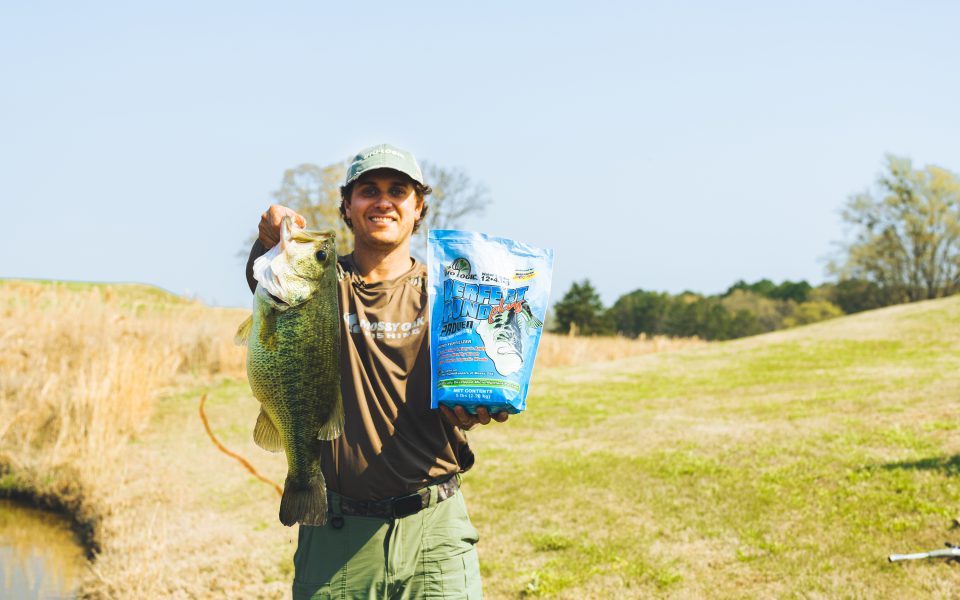Managing private ponds or lakes to produce bigger bass quicker follows many of the same principles deer breeders use to produce a buck with a 200-inch rack in a couple years. However, superior genetics without several other ingredients won’t give you the fat-belly lunker bass you hope to have in a short time. Much research and study has been done to develop a bass strain that will grow bigger, quicker and bite better in private waters.

Eric Engbrestson
Grow Big Bass Like Deer Farmers Grow Big Bucks
 “In the early days of bass genetics research, we assumed that stocking private waters with the Florida strain of largemouth bass was the solution to growing bass bigger and faster, since Florida bass seemed to exhibit a faster growth rate than northern bass,” said Barry Smith, fisheries biologist and one of the founders of American Sportfish. “So, companies that produced bass for stocking used the Florida strain of bass, especially in the South. However, our customers sometimes complained, saying, “Yeah, we’ve got some big bass in our lake, but now we can’t catch them!” We learned that one of the tendencies of the Florida black bass was they didn’t readily attack artificial lures. My partner, Don Keller, and I, knew that was a problem we had to solve for our customers.”
“In the early days of bass genetics research, we assumed that stocking private waters with the Florida strain of largemouth bass was the solution to growing bass bigger and faster, since Florida bass seemed to exhibit a faster growth rate than northern bass,” said Barry Smith, fisheries biologist and one of the founders of American Sportfish. “So, companies that produced bass for stocking used the Florida strain of bass, especially in the South. However, our customers sometimes complained, saying, “Yeah, we’ve got some big bass in our lake, but now we can’t catch them!” We learned that one of the tendencies of the Florida black bass was they didn’t readily attack artificial lures. My partner, Don Keller, and I, knew that was a problem we had to solve for our customers.”
At that same time, deer biologists were conducting research on growing bigger deer quicker in enclosures. The two main components required in yielding a buck with 200-inches or more of antlers within two years were super genetics plus plenty of food. If a buck with the best genetics was put in a hardwood or pine forest with poor soil types and little natural food, he wouldn’t grow at the same rate as he would inside an enclosure with an abundance of nutritious food.
According to Smith, “When we breed largemouth bass for super genetics, we follow a similar program. Years ago, we believed that by adding Florida bass genetics into small waters, we could increase the growth rate of the pond’s bass, since many Florida lakes produced bass weighing 15 pounds or more. Many people believed they needed Florida bass genes in their impoundments to yield a state record… or possibly a world record. However, we learned this process wasn’t the total solution to growing bigger bass quicker. We realized we had to increase the catchability of those bass, because the Florida strain exhibited a tendency to not attack or try to eat artificial lures.”
 Smith continued, “Don and I electro-fished some of these waters we’d stocked with the Florida strain of bass and turned up large numbers of big bass with total Florida genetics that apparently weren’t being caught. The challenge that Don and I had was how to develop a bass that grew quickly, but was very aggressive and would bite artificial lures.”
Smith continued, “Don and I electro-fished some of these waters we’d stocked with the Florida strain of bass and turned up large numbers of big bass with total Florida genetics that apparently weren’t being caught. The challenge that Don and I had was how to develop a bass that grew quickly, but was very aggressive and would bite artificial lures.”
Keller and Smith studied the literature and the genetic records from fisheries biologists in various state and academic research facilities. The consensus was that the northern bass were much more aggressive than the Florida bass. They then selected female Florida black bass that were ten-pounds or bigger, which had been produced by females weighing 10 pounds or more for one or two generations as their brood stock. They bred those Florida bass with aggressive male northern bass that exhibited excellent growth rates. They hoped that some of the offspring would grow bigger, quicker and bite artificial lures more readily than the pure Florida black bass would.
They developed a fish technically known as an “F1 hybrid” from their hatchery. “Through several years of trial and error, we produced F1 hybrid bass that grew from 2-inch fingerlings to 4-pound bass in one year under ideal conditions,” Smith says. “We knew that because of the bass genetics we were using, and our tracking the bass, that these bass had better genetics than other Florida hybrids. That’s why we registered our later generations of Florida hybrids as Tiger bass.”

Feeding Bass, Fertilizing and Liming
Knowing that other factors besides genetics played a role in increasing the growth rates of the Tiger bass, Keller and Smith also identified that food was a limiting factor to a bass reaching its genetic potential in one year or more. They learned a bass needed to eat 10 pounds of food, primarily baitfish, to gain an additional pound, and that that food should be readily available all year.
 Raising big bass quicker was much like cattle farming. You could breed a cow with the best genetics to a bull proven to have the best genetics. However, if you put their offspring in a pasture with little forage and didn’t feed those calves good food, they never would express the full potential of those genetics.
Raising big bass quicker was much like cattle farming. You could breed a cow with the best genetics to a bull proven to have the best genetics. However, if you put their offspring in a pasture with little forage and didn’t feed those calves good food, they never would express the full potential of those genetics.
The same was true of growing bass. For those bass to reach their full potential, Smith and Keller had to increase the stocking rates of forage fish in private lakes and ponds to satisfy the number of bass. To produce Tiger bass, previously they had stocked 1,000 bluegills and shellcrackers per acre: to 100 bass per acre. American Sport Fish then began recommending stocking 1,500-2,000 pounds of bluegills and shellcrackers per acre. It could be done if the water will support that number, and the water was fertilized and limed as recommended. The company also reduced the number of bass stocked. They went to 50 to 75 Tiger bass per acre, instead of 100 bass per acre. Then the Tiger bass had more food available plus their superb genetics to grow larger much faster.
Today, Smith also recommends using feeders to feed bluegills a high-protein fish food for the bluegills to grow faster and produce more offspring. Often lake and pond owners think that the food dispensed by feeders is feeding the bass, but the reality is that that the feed is for the bluegills and shellcrackers, on which the bass then feed upon. When the bluegills and shellcrackers become bigger and fatter, they spawn more offspring that go on to also feed the bass.
“Fertilizing and liming your pond at the recommended rate translates into helping grow big bass quicker,” Smith reports. Water soluble fertilizer like BioLogic Perfect Pond Plus can easily be applied with little hassle. “You also can add supplemental forage fish to your pond to increase the food the bass have to eat. For instance, threadfin shad are prolific spawners, but are “filter feeders” so they feed on a different type of food than the bluegills do. To consistently produce bigger bass quicker, use some type of supplemental forage like the threadfin shad.”
Know the Essentials for Growing Big Bass
 To grow big bass quicker, Smith emphasizes you need to:
To grow big bass quicker, Smith emphasizes you need to:
- Stock your ponds with bass that have superior genetics.
- Keep your pond well-fertilized and limed (Northern ponds will likely not need fertilizer).
- Supplement the bass with all they can eat, use spin feeders to grow bluegills bigger and faster and add additional forage fish like threadfin shad to the lake; and
- Selectively harvest your bass every year to keep from having a buildup of smaller bass that will eat up most of the forage fish and stunt the larger bass. During the first year, the bass you originally have stocked in your pond will have their first spawn, and you won’t have to remove smaller bass. However, during the second year, you want to harvest little bass as soon as they’re big enough to be caught. If your original stocking of bass are 16-inches long at the end of the first or the second year, you want to harvest as many of the smaller bass less than 16 inches as possible.
Whether you’re attempting to produce a buck with 200 plus inches of antlers (behind a high fence) within a couple years, or a largemouth bass that can weigh 10 pounds or more in four years, you’ll have to intensively manage the land and the water. The available food and every aspect of the deer or bass’s environment need to be overseen to reach those goals; all while implementing the latest scientific research available.








